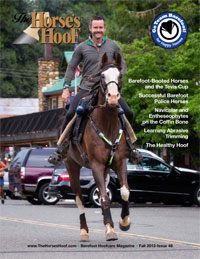–Gwenyth Browning Jones Santagate
The trail was gorgeous that morning. Tall pine trees filtered the early
morning sun and glinted on the rocks that scattered the forest floor.
Dobbin was trotting along nicely, carrying his human, when without a
second’s notice he froze, spun and bolted back down the trail in the
opposite direction. What !!?? What was it? Upon investigation later, on
foot, the human discovered a rock right to the left of the trail where the
horse spooked. It was loaded with Mica and sparkled in the sunlight.
The horse reacted to the sparkles thinking he was in perilous danger. His
equine flight instinct took over any cognitive response of thinking, “Oh,
that’s just a rock! Cool!” … and instead he saw the glints as life-
threatening promises just waiting to eat him.
The human thinks, “Silly horse!”
The horse thinks, “DANGER! I outta here!”
And so it goes.
As horse owners and riders I’m sure we’ve all experienced such an event at
one time or another. If not, you will. Sometime or other. It comes with the
‘equestrian experience’.
The following excerpts about the Brain were taken from
http://mybrainnotes.com/brain-fear-autism.html
While it pertains mostly to the human brain there are similarities and
peculiarities that are pointed out with regard to animal brains. A glossary of the underlined words follows in this article for reference to specific words that are not necessarily common in every day communication. Italicized sentences are my highlights to help you, the reader, pick out the pertinent information for understanding how horses think and react during flight behavior. My comments will be in brackets [brackets].
“Dr. Lanius has elegantly demonstrated how people’s brain function differs when they are in dissociate states [fear states]. … We always suspected that when people go into these states, there is a decrease in activation of the left inferior prefrontal cortex [cognitive thinking area of the brain. [Left brain = analytical, etc. Right brain = emotional] —meaning that people are less capable of taking in new information and being curious about the world out there—and that the brain shifts to a more right posterior activation—more to a state of fear and flight.” [Think, now, of the difficulty in trying to train/teach a horse when that horse gets frightened or feels threatened via punishment training vs. positive reinforcement training].
“There is interesting evidence of a mechanism within the human brain that helps suppress troubling memories and thoughts in a way that is healing. In Animals in Translation, Grandin and Johnson draw attention to Ruth Lanius et al., “The Nature of Traumatic Memories: A 4-T fMRI Functional Connectivity Analysis.” During the study, brain scans were conducted for eleven people with PTSD as a result of sexual abuse, assault, or car crashes as well as for thirteen people who had suffered the similar experiences without developing PTSD. Those who suffered from PTSD remembered their trauma visually, more like a flashback, while those without PTSD remembered their trauma as a verbal narrative. [Humans can VERBALIZE their fears; talk about them and work them out in verbal narrative vs. Horses who have no verbal capabilities. Thus, they remain in a PTSD state of visual stimulus.]
“If language helps humans suppress fear, it is easier to understand why animals do not possess the same ability to suppress fear as people do. Grandin, who has made a career working with animals, asserts: “I do know that once an animal has become traumatized it’s impossible to un-traumatize him. Animals never unlearn a bad fear.” Grandin and Johnson point out that animals are aware of tiny details in their environments and can become afraid of these tiny details. The authors describe this as “hyper-specific” fear. “It comes from autism research, because autistic people are extremely hyper-specific. You see the trees better than the forest. A lot of times you might not see the forest at all. Just trees, trees, and more trees.” The authors point out that animals will react fearfully to any stimulus that resembles, in terms of sensory perception, an initial fearful experience. They describe a dog’s encounter with a red hot-air balloon which severely frightened the animal. Subsequently, the dog reacted fearfully to any red, circular object, even the read aerial markers that draw attention to power lines.”
In Animals in Translation, Grandin and Johnson write: “It seems likely that animals and autistic people both have hyper-fear systems in large part because their frontal lobes are less powerful compared to the frontal lobes in typical folks. [They are not able to consciously/cognitively think, analyze the situation, make decisions etc.] The prefrontal cortex gives humans some freedom of action in life, including some freedom from fear. As a rule, normal people have more power to suppress fear, and to make decisions in the face of fear, than animals or (most) autistic people.”
Regarding the frontal lobes, Grandin and Johnson write: “The frontal lobes fight fear in two ways. First, the frontal lobes are the brakes. [since the frontal lobe in horses is much smaller than humans’, it is not able to “brake/stop” the fear once fear has started to root in] The frontal lobes tamp down the [action of the] amygdala …. The amygdala tells the pituitary to pump out stress hormones such as cortisol; the prefrontal cortex tells the pituitary to slow down.”
Grandin and Johnson point to a core difference between animals and autistic people on the one hand, and normal people on the other. “Animals and autistic people are splitters. They see the differences between things more than the similarities. In practice this means animals don’t generalize very well.”
GLOSSARY:
Amygdala: a ganglion of the limbic system adjoining the temporal lobe ofthe brain and involved in emotions of fear and aggression. More on this can be found here: http://brainmind.com/LanguageReality.html especially about vibratory stimulus and how it affects the amygdala. The clicker, used in Clicker Training, is capable of reaching the amygdala and interrupting the flight/fight transmissions thus the ‘success’ of Clicker Training is rapid learning with horses.
Cognitive: of or pertaining to the mental processes of perception,memory, judgment, and reasoning, as contrasted withemotional and volitional processes.
Prefrontal Cortex: the gray matter of the anterior part of the frontal lobe that is highly developed in humans and plays a role in the regulation of complex cognitive, emotional, and behavioral functioning
PTSD: post-traumatic stress disorder












One thought on “Understanding Equine Fear Behavior”